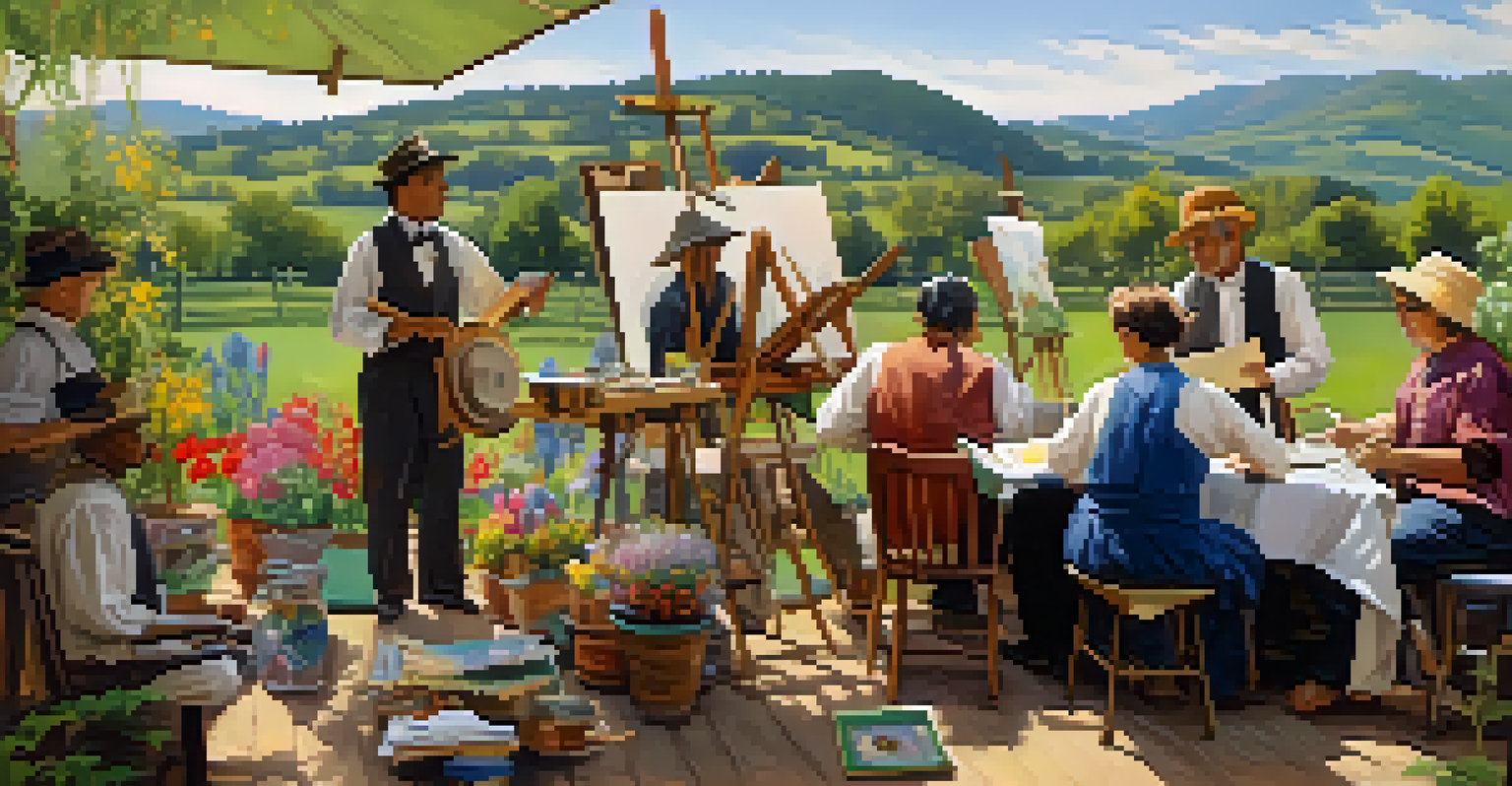The Rise of California Impressionism: A Lasting Influence

Understanding California Impressionism and Its Origins
California Impressionism emerged in the late 19th century, a response to the vibrant landscapes and unique light of the West Coast. Artists sought to capture the fleeting qualities of light and color, much like their French Impressionist counterparts. However, they added their own twist, incorporating the distinct natural beauty of California into their works.
The essence of California is the light. It’s the light that inspires us and makes our art unique.
This movement was not just about painting; it was also about a lifestyle shift. Many artists migrated to California, drawn by its warm climate and inspiring scenery. The influx of these creative minds brought together diverse influences and sparked a new artistic dialogue that would shape the region's cultural landscape.
Key figures like Guy Rose and William Wendt played pivotal roles in defining this style. Their works showcased not only the beauty of California’s coastline and mountains but also reflected the broader American experience, bridging European techniques with local themes.
Key Characteristics of California Impressionist Art
California Impressionism is known for its vibrant colors, loose brushwork, and emphasis on natural light. Artists often painted en plein air, or 'in the open air,' allowing them to capture the essence of a moment. This technique differentiated their work from more traditional, studio-based approaches, which often lacked the spontaneity found in these outdoor settings.

You might notice that many California Impressionist paintings evoke a sense of immediacy, as if the viewer is right there in the moment. The use of bold colors reflects the sun-drenched landscapes, from golden hills to azure skies, creating an emotional connection with the viewer. This focus on light and atmosphere became a signature of the movement.
Origins of California Impressionism
California Impressionism emerged in the late 19th century as artists sought to capture the unique light and landscapes of the West Coast.
Another distinguishing feature is the way artists depict local flora and fauna. Instead of generic landscapes, they embraced the unique plant life and coastal scenes of California, showcasing the state's beauty in a way that felt authentic and relatable.
Notable Artists and Their Contributions
Several artists stand out in the California Impressionism movement, each contributing unique perspectives. For example, William Wendt is often referred to as the 'dean' of California Impressionism, known for his large landscapes that celebrated the state's natural beauty. His works often depict serene scenes that invite reflection and appreciation of the outdoors.
Art is the most beautiful of all lies; it’s the truth behind the colors and forms that captivates us.
Another prominent figure, Edgar Payne, is celebrated for his dynamic compositions that often included the rugged coastlines and majestic mountains of California. His ability to convey movement through brushstrokes and color choices made his pieces feel alive, drawing viewers into the scene more deeply.
Lastly, we can't overlook the contributions of artists like Guy Rose and Ambrose Patterson, who enriched the movement with their innovative techniques and perspectives. Together, these artists not only shaped California Impressionism but also influenced future generations of American artists.
The Influence of California Impressionism on American Art
California Impressionism played a significant role in shaping the trajectory of American art in the 20th century. Its focus on light, color, and the natural world resonated with artists across the country, inspiring them to explore similar themes in their own work. This movement served as a bridge between European Impressionism and the burgeoning American art scene.
As artists began to adopt and adapt the techniques of California Impressionism, they fostered a unique American identity in art. This influence can be seen in various movements that followed, including the American Scene Painting and Regionalism, which emphasized local landscapes and cultural narratives.
Key Characteristics of the Style
The movement is distinguished by vibrant colors, loose brushwork, and a focus on natural light, often painted en plein air to evoke immediacy.
The legacy of California Impressionism extends beyond just painting; it has inspired countless artists, photographers, and filmmakers to capture the essence of the California experience. This ongoing dialogue between nature and art continues to thrive today, ensuring that the spirit of this movement remains alive.
The Role of Art Colonies in the Movement's Growth
Art colonies played a vital role in nurturing the California Impressionism movement. Places like Laguna Beach and Carmel-by-the-Sea became hubs where artists gathered to share ideas, techniques, and inspiration. These communities fostered collaboration and experimentation, allowing artists to push the boundaries of their craft.
The camaraderie found in these colonies often led to artistic breakthroughs. For instance, group exhibitions and informal critiques helped artists refine their styles and elevate their work to new heights. This supportive environment created a nurturing space for creativity to flourish.
Furthermore, the art colonies helped establish a sense of camaraderie among artists, giving them a platform to promote their work. This collective spirit contributed to the broader acceptance of California Impressionism, allowing it to gain recognition both locally and nationally.
Challenges and Evolution of California Impressionism
Despite its successes, California Impressionism faced its share of challenges. The rise of modernism in the early 20th century posed a significant threat, as artists began to explore abstraction and new forms of expression. Many traditional Impressionists struggled to adapt to these changing tides, leading to a decline in popularity.
However, rather than fading away, California Impressionism evolved. Artists began to incorporate modern techniques while still honoring the principles of light and color that defined their work. This adaptability allowed them to remain relevant in an ever-changing art landscape.
Enduring Influence on Art
California Impressionism has significantly shaped American art, inspiring contemporary artists to explore themes of light, nature, and sustainability.
Today, we see a resurgence of interest in California Impressionism, as artists and collectors alike recognize its historical significance. The movement's ability to blend tradition with innovation serves as a reminder of the dynamic nature of art and its capacity to evolve over time.
California Impressionism's Lasting Impact on Contemporary Art
California Impressionism continues to influence contemporary artists in various ways. Many modern painters draw inspiration from the movement's emphasis on light, color, and the beauty of nature. This connection to the environment resonates with current artistic themes, such as sustainability and ecological awareness.
Furthermore, the techniques popularized by California Impressionists, like plein air painting, are still widely practiced today. Artists often venture outdoors to capture landscapes in real time, mirroring the practices of their predecessors while adding their unique interpretations.

The legacy of California Impressionism is evident in art galleries and museums, where its works continue to inspire and educate new generations. By understanding this movement, contemporary artists can appreciate the rich history that informs their practice, creating a bridge between the past and the present.